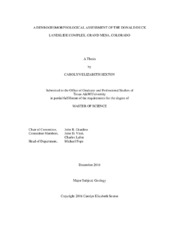| dc.contributor.advisor | Giardino, John R | |
| dc.creator | Sexton, Carolyn Elizabeth | |
| dc.date.accessioned | 2017-03-02T16:45:19Z | |
| dc.date.available | 2018-12-01T07:21:00Z | |
| dc.date.created | 2016-12 | |
| dc.date.issued | 2016-10-06 | |
| dc.date.submitted | December 2016 | |
| dc.identifier.uri | https://hdl.handle.net/1969.1/158968 | |
| dc.description.abstract | Grand Mesa, Colorado exhibits numerous dynamic geomorphologic phenomena, including ancient and currently active features of mass movement. The dense, basaltic mesa top that makes up Grand Mesa is underlain by weak Tertiary strata that is highly susceptible to slope failure. Together, these formations have historically produced slump-block failures along the flanks of the mesa. This thesis investigates the landslide complex on the north flank of Grand Mesa along Highway 65, where periodic landslides block and damage the roadway. The United States Forest Service has inquired as to why these events are occurring and if it is possible that the landslide will stabilize.
Geomorphic mapping in conjunction with dendrochronological methods were used to determine the frequency, direction, and magnitude of mass movements associated with the landslide complex. Weather data were collected from local stations and compared with the dendrogeomorphological data to pinpoint the threshold amount of precipitation that could initiate movement on the landslide complex.
The Donald Duck landslide complex is 150m x 100m and situated on the eastern flank of an ancient landslide that originated at a toreva block along the top of the mesa. The ancient landslide originated south of the DDLC, 1km above, and terminates north at the valley floor 1.4km below. Three distinct lobes of movement were identified in the landslide complex, and eighty-eight cross-sections were taken from trees that are situated on and adjacent to the landslide complex. Tree ages on the complex indicate that the landslide was activated in the early 1960s. This time-frame corresponds to when Highway 65 was re-routed to its current location, which would have resulted in the stabilizing soil at the base of the slope being removed. Subsequent movement of the complex appears to occur after above-average precipitation events (+1 Std. Dev.) and results in material flow that impacts the highway. The three distinct lobes on the complex then pulse and creep in tandem approaching re-stabilization.
The Donald Duck Landslide complex was first activated in its entirety in the early 1960s and moved toward the northwest. Subsequent movement has occurred in the same general direction after periods of extreme rainfall followed by extreme drought, resulting in only surficial creep movement. | en |
| dc.format.mimetype | application/pdf | |
| dc.language.iso | en | |
| dc.subject | geomorphology | en |
| dc.subject | dendrochronology | en |
| dc.subject | landslide | en |
| dc.subject | Grand Mesa, CO | en |
| dc.subject | glacial till | en |
| dc.subject | climatic fluctuation | en |
| dc.subject | mass-movement re-activation | en |
| dc.title | A Dendrogeomorphological Assessment of the Donald Duck Landslide Complex, Grand Mesa, Colorado | en |
| dc.type | Thesis | en |
| thesis.degree.department | Geology and Geophysics | en |
| thesis.degree.discipline | Geology | en |
| thesis.degree.grantor | Texas A & M University | en |
| thesis.degree.name | Master of Science | en |
| thesis.degree.level | Masters | en |
| dc.contributor.committeeMember | Vitek, John D | |
| dc.contributor.committeeMember | Lafon, Charles W | |
| dc.type.material | text | en |
| dc.date.updated | 2017-03-02T16:45:19Z | |
| local.embargo.terms | 2018-12-01 | |
| local.etdauthor.orcid | 0000-0003-0427-2364 | |


